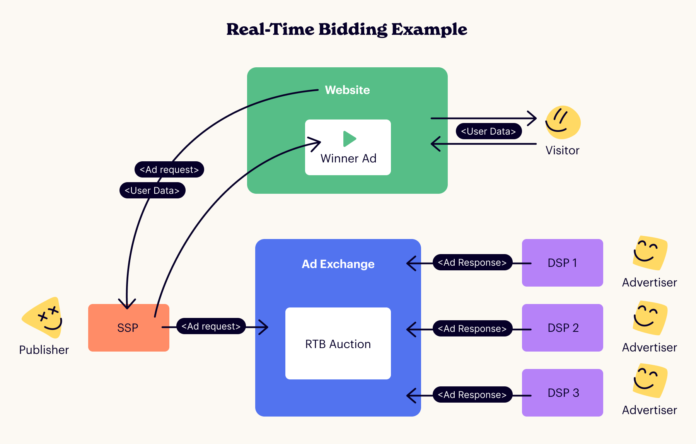Real-time bidding (RTB) is a key component of programmatic advertising, revolutionizing the way advertisers buy and sell ad inventory in real time. It has transformed the digital advertising landscape by allowing advertisers to target their audience more precisely and optimize their ad spend efficiently.
In this review, we will explore the advantages and disadvantages of real-time bidding, its impact on traffic, promotion channels, and conversion rates.
Real-time bidding

One of the significant benefits of real-time bidding is its ability to drive targeted traffic to advertisers’ websites or landing pages. Through RTB, advertisers can reach their desired audience based on various targeting parameters such as demographics, interests, browsing behavior, and location. This precision targeting ensures that ads are delivered to the most relevant users, increasing the likelihood of engagement and conversion. By reaching the right users at the right time, real-time bidding maximizes the potential of ad campaigns to generate high-quality traffic.
Furthermore, real-time bidding opens up diverse promotion channels for advertisers. Ad inventory available through RTB is not limited to specific websites or publishers. Instead, it encompasses a vast network of publishers and ad exchanges, providing advertisers with an extensive reach and exposure to different audiences. Advertisers can take advantage of this broad availability of inventory to explore various channels, including display ads, mobile advertising, video ads, and native advertising. The flexibility in choosing promotion channels allows advertisers to diversify their ad placements and adapt their strategies to specific campaign goals.
Adversting

In terms of conversion rates, real-time bidding offers opportunities for optimization and improved performance. Advertisers can leverage real-time data and insights provided by demand-side platforms (DSPs) to monitor the performance of their campaigns and make data-driven decisions. By analyzing metrics such as click-through rates (CTR), engagement rates, and conversion rates, advertisers can identify what is working and what needs improvement. This ability to optimize campaigns in real time allows advertisers to allocate their budget more effectively, maximizing their return on investment (ROI) and achieving higher conversion rates.
Despite its advantages, real-time bidding also has its challenges. Advertisers need to be cautious about ad fraud, which can occur when low-quality or fraudulent inventory is presented through RTB. Advertisers should partner with reputable ad exchanges and demand-side platforms that have robust fraud detection mechanisms in place to minimize the risk of ad fraud. It is also crucial to have clear visibility into the ad placements to ensure that ads appear in brand-safe environments and align with the advertiser’s values and objectives.
Another challenge of real-time bidding is the complexity of the ecosystem. Advertisers need to navigate through various platforms, exchanges, and data sources to optimize their campaigns effectively. This complexity requires a certain level of expertise and resources to manage RTB campaigns successfully. Advertisers may consider partnering with specialized agencies or employing in-house experts to handle the intricacies of real-time bidding.
Privacy concerns are also prevalent in the digital advertising landscape. With the increasing emphasis on data privacy and regulations such as the General Data Protection Regulation (GDPR) and the California Consumer Privacy Act (CCPA), advertisers must ensure compliance with privacy policies and respect user consent. Transparency in data collection and usage is essential to build trust with users and maintain a positive reputation.
In addition to the benefits and challenges mentioned above, real-time bidding also offers advertisers the advantage of cost efficiency. With RTB, advertisers have the ability to bid on ad impressions in real time, allowing them to optimize their ad spend and allocate their budget more effectively. Advertisers can set bid limits and adjust their bids based on the value they perceive for each impression, ensuring that they are getting the most out of their advertising budget.
Moreover, real-time bidding provides valuable insights and data that can inform future advertising strategies. By analyzing the data gathered from RTB campaigns, advertisers can gain a deeper understanding of their target audience, their preferences, and their behaviors. This information can be used to refine targeting parameters, optimize ad creatives, and tailor messaging to increase the chances of conversion. Real-time bidding allows advertisers to make data-driven decisions and continuously improve their campaigns to achieve better results.
Another aspect worth mentioning is the scalability of real-time bidding. Whether advertisers have a small budget or a large one, RTB can accommodate their needs. Advertisers can start with a modest budget and gradually increase it as they see positive results. Real-time bidding provides flexibility in terms of budget allocation, allowing advertisers to test and iterate their campaigns, and scale them up as they find success.
On the downside, real-time bidding can be highly competitive. Advertisers are bidding against each other in real time for ad impressions, which can drive up the costs and make it challenging to secure desirable placements. Advertisers need to carefully analyze the market and optimize their bidding strategies to ensure they are maximizing their ROI while still securing the necessary ad placements to reach their target audience.
Additionally, real-time bidding requires technical expertise and resources to implement and manage effectively. Advertisers need to have access to a demand-side platform (DSP) or work with a trusted DSP partner to participate in the real-time bidding ecosystem. They also need to have a solid understanding of the platforms, tools, and algorithms involved in RTB to make informed decisions and optimize their campaigns.
Conclusion

real-time bidding is a powerful tool in the realm of digital advertising that offers numerous advantages, including targeted traffic, access to diverse promotion channels, optimization opportunities, cost efficiency, valuable data insights, and scalability. However, it also presents challenges such as competition, the need for technical expertise, and the requirement for careful budget management. By understanding these aspects and implementing strategic approaches, advertisers can harness the potential of real-time bidding to drive effective advertising campaigns and achieve their marketing objectives in an increasingly competitive and dynamic digital landscape.




